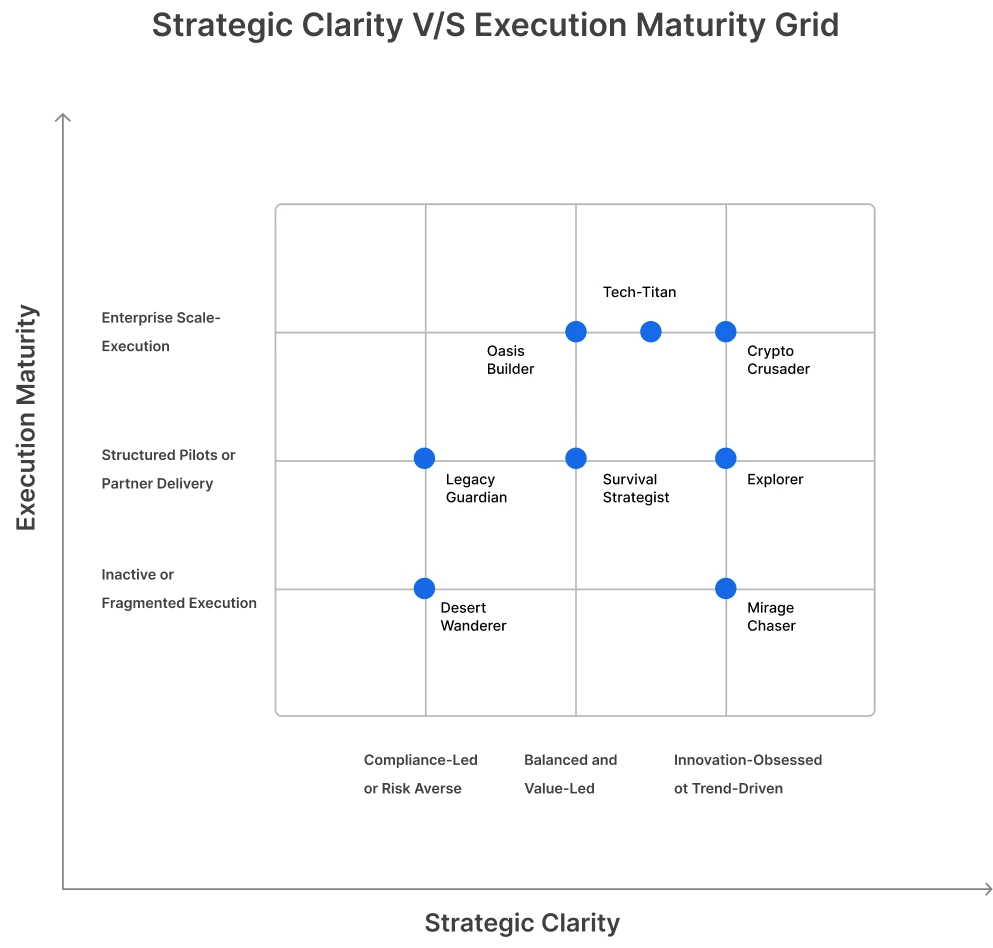Streamlining Transaction Banking for Corporates.

FinnAxia® Global Receivables
Simplify Collections. Strengthen Liquidity. Scale Confidently.
Learn moreWhy transformation efforts stall (and how to decode your digital behaviour before it happens).
Let’s be honest: most digital transformation efforts in banking don’t fail because of bad technology. They fail because of mismatched behaviour: intentions that never make it to execution, teams pulling in different directions, and leaders who think they’re transforming but are really circling in place.
It’s not a tech issue. It’s a behavioural one.
Banks throw millions at new platforms, but progress feels stuck. Some launch 15 pilots and don’t scale one. Others build for compliance instead of customer value. A few go all-in on blockchain while the rest of the org still runs on legacy batch systems. Sound familiar?
Digital transformation isn’t just about tools; it’s about how institutions think, prioritize, and act. That behaviour is often invisible until it’s too late. Which is exactly what we aim to solve.
We call it the Fintech Persona Model, and it helps you name and map your digital behaviour before it derails your strategy.

This is for leaders at FinTech’s and financial institutions who are tired of investing in transformation without knowing what’s actually working.
If you’re a CEO, CIO, Chief Transformation Officer, or business unit head trying to:
This might be your mirror.
There are two behaviors that define your FinTech Persona:
These two axes reveal a behavioural fingerprint. When you map them, you land in one of eight personas. Each one has a logic. A strength. And a risk. Knowing your persona can tell you how to evolve to achieve your vision.
You’ll probably recognize your organization in one (or more) of these. That’s the point.
You’re the rare bank that actually aligns strategy with delivery. You think in platforms, not products. You scale smart. Innovation here isn’t noise but structural. You build slowly, but you build right. The catch? You may get too comfortable, too orchestrated. Disruption might sneak past you while you’re still aligning a steering committee.
You go big, fast. You acquire, integrate, and launch like a digital war machine. You’ve got the capital, the brand, and the boardroom backing to change direction overnight. Your biggest risk is Complexity. And eventually, trust. Regulators don’t love a giant moving too fast with too much data.
You test everything. Hackathons, MVPs, sandbox this, prototype that. Your teams are buzzing with ideas. But it’s hard to tell if any of them stick. There’s little structure. You celebrate pilots more than outcomes. A great culture, but if you don’t centralize, you’ll stall.
You’ve got the sleek app. The chatbot. The fintech partnership. But no real change under the hood. Your transformation looks good on stage, but struggles in the balance sheet. When pressure hits, you’ll be the first to cut funding because ROI is fuzzy.
You know you can’t build it all, so you plug into better tech. You survive by partnering smart. It’s agile, but fragile; overreliance on external vendors could trap you. Still, in tough times, you’re better positioned than most to pivot fast.
You move carefully, and you’re hard to disrupt. Clients trust you. Regulators trust you. But speed isn’t your game. You avoid risk, which makes sense until the world changes and you’re stuck with 20-year-old systems and talent attrition.
You believe the future of finance is decentralized, transparent, and tokenized. You experiment on the edge, maybe even help shape regulation. But the present still operates in central systems, and until the two worlds align, you’ll be visionary but also high-risk.
You’re not against digital, you’re just stuck. There’s no unifying vision. Every change feels tactical, like catching up instead of stepping ahead. Sometimes it’s culture, sometimes leadership churn, often it’s fear. However, the truth is that even Wanderers can evolve.
| Persona | Trends That Help | Why It Helps | Trends That Hurt | Why It Hurts |
|---|---|---|---|---|
| Oasis Builder | API banking, data unification, composable platforms | Supports modular, integrated strategy execution | Tool fragmentation, fast-evolving AI stack | Creates complexity, threatens cross-functional alignment |
| Tech Titan | Generative AI, CBDCs, fintech M&A opportunities | Fuels scale, innovation at speed, and market dominance | Regulatory scrutiny, data ethics concerns | Big players face trust erosion and compliance risk |
| Explorer | No-code tools, regulatory sandboxes, embedded finance APIs | Enables low-cost experimentation and grassroots innovation | Integration debt, economic cost-cutting | Pilots stall without scale or ROI clarity |
| Mirage Chaser | UX design, chatbots, gamified CX layers | Keeps transformation visible and appealing to stakeholders | Core infra shifts, real-time system demands | Exposes lack of depth, fragile back-end readiness |
| Survival Strategist | BaaS, fintech partnerships, open banking mandates | Aligns with partnership-led model and modular plug-ins | Vendor lock-in, API security and compliance risks | Reliance on others introduces exposure if standards shift |
| Legacy Guardian | Regulatory toolkits, legacy wrapper solutions | Allows risk-mitigated modernization in familiar, gradual steps | Instant payments, 24/7 CX expectations | Their slow pace doesn’t match customer or regulator timelines |
| Crypto Crusader | Tokenization, DeFi infrastructure, smart contracts | Validates the decentralization thesis and future finance models | Regulatory limbo, institutional hesitation | High potential, but unclear policy frameworks limit real-world application |
| Desert Wanderer | National digital infra (UPI, e-KYC), government mandates | External push gives momentum without needing internal leadership | Digital challengers, internal brain drain | Their caution creates relevance risk as others attract customers and talent |
Knowing your Fintech Persona is about identifying behaviour patterns so you can change them.
This model helps you:
Most importantly, it gives you language. Language to talk transformation without hiding behind tech jargon. Language to spot gaps between your strategy and your execution.
Answer these two questions:
Q. What most often drives your digital decisions?
A. Customer experience
B. Efficiency and cost
C. Industry pressure or trends
D. Tech innovation and experimentation
E. Compliance and regulatory triggers
F. Revenue generation and monetization
Q. How do you usually execute?
1. Pilots and MVPs
2. Structured roadmap
3. Department-driven innovation
4. Partnering or acquisitions
5. Cautious, compliance-led rollouts
6. Enterprise-wide scaled execution
| Execution ↓ / Strategy → | A: Customer-Centric | B: Efficiency | C: Trend-Following | D: Tech-First | E: Compliance | F: Revenue-Hungry |
|---|---|---|---|---|---|---|
| 1. You test and learn | Explorer | Explorer | Mirage Chaser | Crypto Crusader | Mirage Chaser | Explorer |
| 2. You follow a roadmap | Oasis Builder | Oasis Builder | Tech Titan | Tech Titan | Oasis Builder | Tech Titan |
| 3. You enable team-level action | Explorer | Mirage Chaser | Mirage Chaser | Explorer | Legacy Guardian | Explorer |
| 4. You grow through partnerships | Survival Strategist | Survival Strategist | Tech Titan | Tech Titan | Survival Strategist | Tech Titan |
| 5. You move carefully | Legacy Guardian | Legacy Guardian | Desert Wanderer | Desert Wanderer | Legacy Guardian | Mirage Chaser |
| 6. You scale enterprise-wide | Oasis Builder | Tech Titan | Tech Titan | Crypto Crusader | Oasis Builder | Tech Titan |
That’s your starting point. From there, we can map out your path.
Digital transformation isn’t a linear journey. It’s behavioural. Your projects will fail or fly based on how aligned your vision is with your delivery culture. This model intends to capture not what you’re building, but how you behave while building it.
And once you know that, you can decide: double down, or evolve.
At Nucleus Software, we use this framework to:
Because no matter how smart your tech roadmap is, it won’t land unless your institutional behaviour can carry it.
And the truth is, your digital persona isn’t permanent. It’s potential.
Let’s find yours and turn it into your next competitive advantage.
Each path below starts with a current persona experiencing friction or limited outcomes and maps toward a stronger, more aligned persona, along with the critical shifts needed to get there.
Desert Wanderer → Legacy Guardian → Survival Strategist → Oasis Builder
Mirage Chaser → Explorer → Oasis Builder
Explorer → Aligned Strategy Driver → Tech Titan or Oasis Builder
Legacy Guardian → Survival Strategist → Oasis Builder
Crypto Crusader → Tech Titan
The most successful transformation journeys are non-linear. You may move horizontally (across strategy types) or vertically (across execution maturity). What matters more is the alignment between what you want to achieve and how your org behaves.
Transformation isn’t a tech roadmap. It’s a behaviour redesign.
